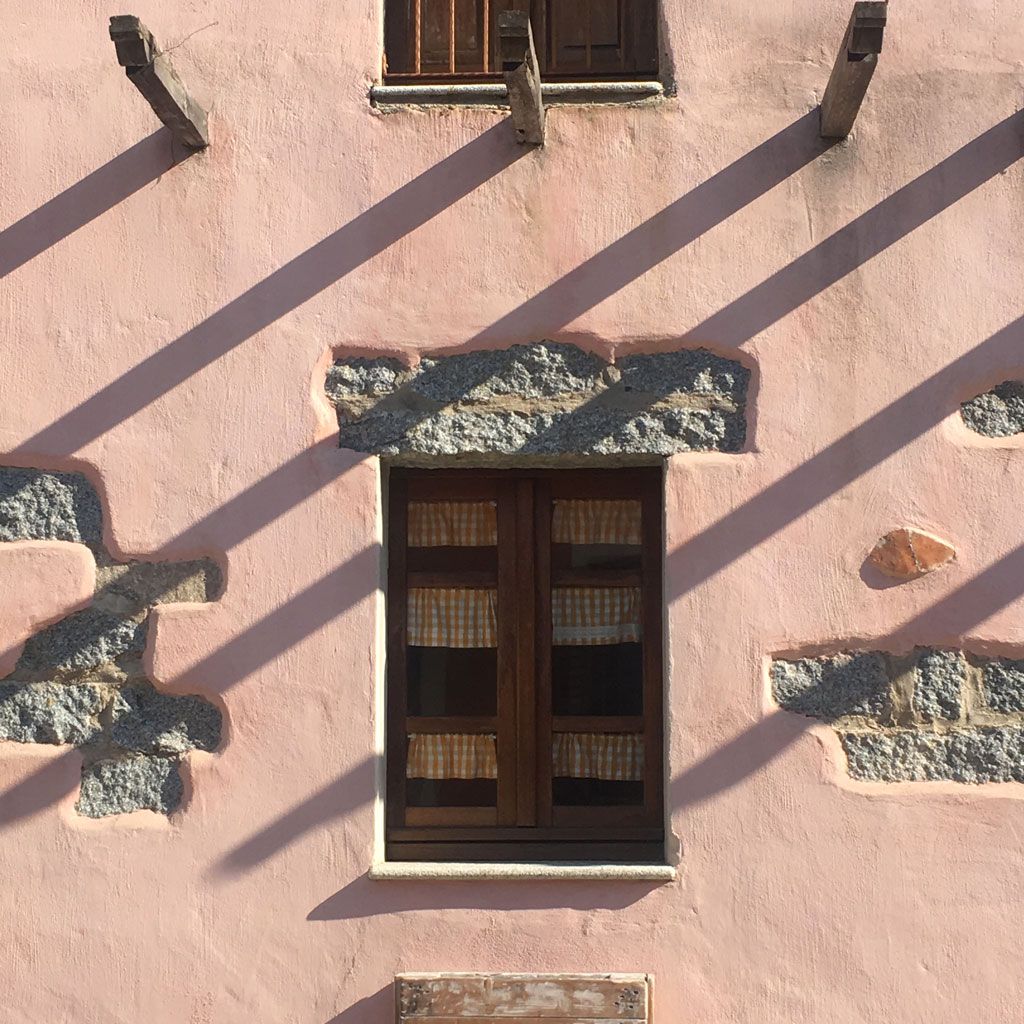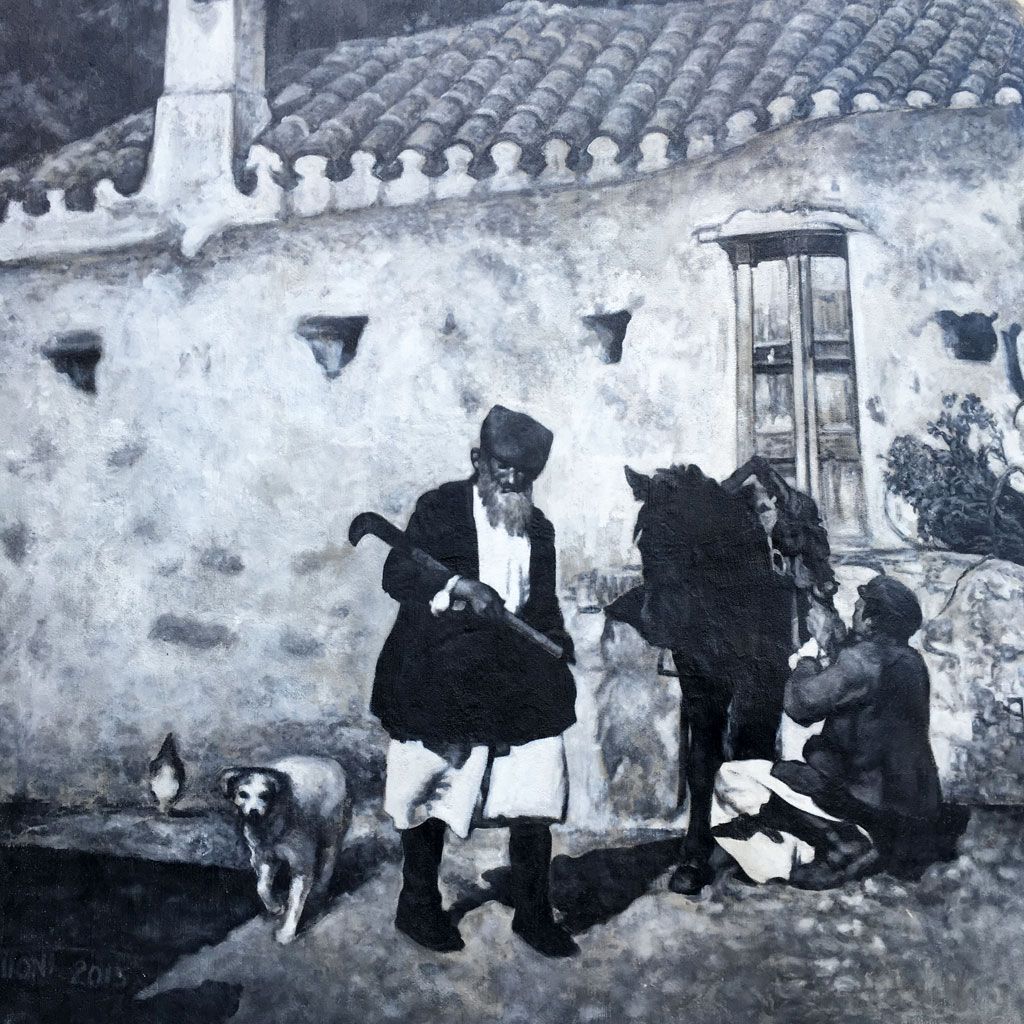
134/377: Urzulei
INSPIRATION

I leave Talana with no rush, today the road will be “mostly” flat. The day is beautiful and the view of the plain below is amazing. I cycle along the side of the mountain and then pass the point where the old village of Mannorri used to be. Shortly after I see Urzulei a little lower, dominated by a calcareous peak that seems to fall on it.
I enter the village and stop at a bar for coffee. The local dialect of some elders worries me: I don’t understand anything! A Sardinian dialect, with an absolutely unique accent, which I had never heard before. I get back on my bike and seeing the beautiful day I stop to work outdoors, in the square where the war memorial is located. Then I walk around the narrow streets of the old village, with many well-kept old houses.

Before lunch my friend Gigi, who lives in Cagliari, but of Urzulei origins, puts me in touch with his cousin Giuseppe who has a b&b and who will host me tonight. I meet him outside the Su Gorropu butcher shop, where I order two sandwiches with local roast meat. Stefano, the owner, does not charge me and wishes me good continuation of the adventure. After leaving my luggage with Giuseppe, I decide to venture into the area above the town.

I get on my bike and cycle along part of the road that I will have to redo tomorrow to go to Dorgali, 4 kilometers of deadly climb towards the 125 road and then a short stretch of it, before taking the left fork that runs along the whole calcareous heel. We are now on the northern border of Ogliastra. I arrive just below the calcareous peak, above the town, and the view of the valley below is one of the most crazy so far, at a height that makes one shiver.

I continue for a breathtaking climb, and finally arrive at the top of Campo Oddeu, a plateau of white limestone. Here it is the beginning of the Supramonte. The only thing I met shortly after is an old Volkswagen motorhome with open doors. I approach to greet and I meet Gerhard and his partner Janu, who offer me a nice coffee. We talk a little and I give them advice on where to continue their journey, as they have no plans. We take a selfie, exchange emails (Gerhard will write to me a few weeks later from Germany to tell me that my advice was very useful!)
After saying goodbye I continue to the limestone field, among wild pigs that cut my way and grazing cows. I descend to a wide valley, and I understand that here the territory is immense, and even risky to go further. A little away from here is the Gorropu gorge, on the border with Orgosolo, I won’t have time to see it on this trip. So I go back and stop behind some rocks, to play the ukulele, with the background of the bells and the bellowing of the cows.

Back in the village I take a stroll around the oldest part of Orthullè (Urzulei’s name of ancient origin), where there are some murals depicting old men in costume. Then I go down to the little church of Sant’Antonio Abate, which is not far from the largest parish of San Giovanni, where mass is being held. A lady who is entering late sees me and asks me “are you Mr. Dessanay? Enjoy your stay in Urzulei “.
In the evening I go to the pizzeria just below the b&b. I am alone but after a while a group of people asks me if I am the friend of Gigi, cousin of two of them, and they join me. It’s Luciano, Simona, Roberto, Elene and Martina, with whom I spend a beautiful evening, and who, besides enriching me with their stories about Urzulei, they pay for my pizza!
SOUND FRAGMENTS
Live at Campo Oddeu

SHORT SARDINIAN STORIES

In the pizzeria, Luciano tells me how pastoralism has always been the main activity here in Urzulei. And he recommends watching two documentaries to better understand this reality (I immediately added them to my “Sardinian watching list”!)
The first is the documentary film Tempus De Baristas by the American director David MacDougall, which describes the life of a family of shepherds who live in the area of the “codule”, isolated valleys in the mountains towards Baunei. It is said that the founders of this family came from the ancient town of Mannorri, between Urzulei and Talana. In the film, as in reality, the young Pietro learned the trade from his father, but modern production techniques and the new market are changing the traditional way of conducting this activity. This family still lives in the codules and some members of the family sometimes are spotted in the village. “See that boy,” Luciano tells me, “he is a ‘ codulesu’, Pietro’s cousin, the movie’s protagonist.”
The case of the shepherd Natteddu is different. An episode of the Geo&Geo program on RAI TV was focused on him. Natteddu lived all his life in a very isolated valley not far from where I was today. He lived in a “pinnettu”, a hut of stones and branches, and led a life of other times, in close contact with nature and animals. In addition to his goats, Natteddu knew well the birds of this area, the griffins and especially the eagles. When someone went to see him he always had stories to tell, in Sardinian. Unfortunately I could not find much about this character, if not the title of the video documentary made by Antonio Pisanu entitled “Il Gennargentu di Natteddu”.